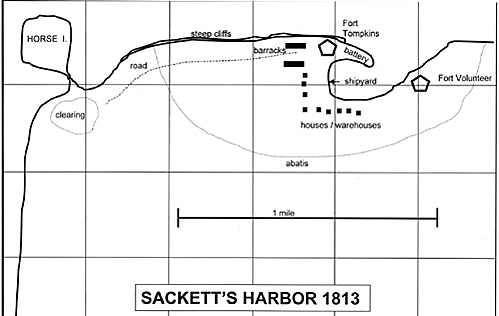Historical Battle
The British landed on the eastern shore of Horse Island and were met by the militia and volunteers. After firing a few volleys, the Americans withdrew or retreated. Some were eventually brought back into the fight toward the very end of the battle. The British and Canadians pushed onward with their left flank along the road. They were met by the regular infantry and dragoons at the abatis.
These Americans were slowly pushed back to the barracks and the western edge of town were they stood. Without wind, the two naval vessels were unable to get good positions from which to support the ground attack. Eventually, worn down by casualties, the British withdrew in an orderly manner back to their bateaux and withdrew to the ships. Unfortunately for the Americans, they perceived that the British were closing in on the shipyard and therefore set fires to the ship under construction and mounds of naval stores.
Before attempting this wargame, I suggest reading a detailed account of this pivotal battle. Of particular value is Patrick Wilder’s critique of the American defense and the British/Canadian attack offered in The Battle of Sackett’s Harbour.
Order of Battle
Exact figures are hard to come by and readers will discover discrepancies among authors. Below I have listed what I use to recreate this encounter. I base my 1812 armies on companies and therefore I use a bit of “rounding” from historic sources.
BRITISH/CANADIAN
2 ships, the Wolfe and the Beresford.
33 batteaux to transport troops from ship to shore.
Royal Scots 200
8th Regt of Foot 150
100th Regt. Of Foot 200
104th Regt. Of Foot 100 (light and grenadier companies)
Canadian Voltigeurs 100
Glengarry Light Inf. 50
For a total of 800 Infantry. Most troops had seen some fighting.
AMERICAN
9th Infantry 50
21st Infantry 100
23rd Infantry 50
1st Light dragoons 300 (50 mounted, rest dismounted)
3rd Artillery 150 (50 crewing guns, 100 as infantry in Fort Tompkins)
Albany Volunteers 200 plus a six pound foot gun
New York Militia 400
Sailors 200 manning a battery along Navy Point
For a total of 1450 Most troops were raw recruits with little training.
Americans had a 32 pound gun in Fort Tompkins and 4 guns from 12 to 32 pounds in a battery along Navy Point
Physical Layout
Please refer to the map. Horse Island was largely but not entirely wooded as was the vast bulk of the battle area. Note the one clearing which we can locate from historical sources.
There were other clearings and you should keep this in mind while laying out your battlefield. I would guess that the abatis was placed in cleared area so that defenders would have an open field of fire as the attackers moved through the abatis. Between Horse Island and Fort Tompkins are steep cliffs. This limits the British landing points. The road is clear and this marked the main advance of the British forces.
The barracks were solidly built and loop-holed and in fact were well defended during the battle. Fort Tompkins had a 32 pound gun which could range Horse Island and the British naval vessels. Both Fort Tompkins and Volunteer were wooden palisaded forts.
Wargaming the Battle
This battle pits trained and experienced British/Canadians against some pretty raw Americans. The British have superior morale and fire effectiveness. Since the British had no good idea what they were up against, I’d start with the American writing down which troops he had positioned where. Then the British player can begin landing and the Americans revealed as the British run into them. This means that the Americans will generally get the first shot of each exchange.
There were several hundred American regulars and militia enroute to Sackett’s Harbor during the battle and these can be duly represented. For example, each turn after the British pierce the abatis, there is a 5% chance that 100 Americans will enter the battlefield immediately east of Fort Volunteer. There is a 50/50 chance that these are regulars. Continue rolling each turn regardless if reinforcements have already shown up. There is no limit to how many reinforcements arrive. This encourages the British player to finish the fight quickly.
The primary purpose of the raid is to burn the American ship under construction and to carry off naval supplies. If the British can drive off the defenders of the shipyard, they can burn the ship. If they can drive the defenders away from Sackett's Harbor (that is, keep them outside the line of abatis) then the British ships can enter the harbor and start loading supplies. If, however, the Americans can counterattack and regain the shipyard, then assume that the British had time to fire the warehouses before they withdrew.
There is also a chance that the Americans will fire the ship and supplies to keep them from falling into enemy hands. For every turn that the British reach or remain on the line of barracks and warehouses, the American player rolls a percentage die. There is a 10% chance that the Americans set fire to the ship and supplies. If the British penetrate Fort Tompkins, there is a 75% chance the Americans fire the ship and supplies. Once the Americans set fire to the ship and supplies, the American player can attempt to put out the fires. He can do this each turn with a probability of 10% for a total of four consecutive turns. After that, the fires are unstoppable.
Victory Conditions
British decisive victory: Ship burned, supplies captured
British marginal: Ship or supplies burned
American decisive: British fail to penetrate abatis
American marginal: Americans retain barracks and forts, ship and supplies safe.
Map

Back to Table of Contents -- War of 1812 #1
Back to War of 1812 List of Issues
Back to MagWeb Magazine List
© Copyright 2001 by Rich Barbuto.
This article appears in MagWeb (Magazine Web) on the Internet World Wide Web.
Other military history articles and gaming articles are available at http://www.magweb.com